30+ SAMPLE Strategic Agreement
-
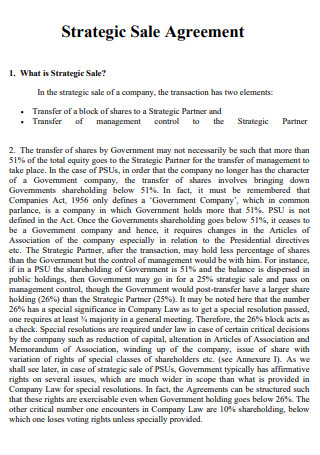
Strategic Sale Agreement
download now -

Strategic Partnership and Cooperation Agreement
download now -

Strategic Partnership Agreement
download now -

Strategic Alliance Agreement
download now -

Strategic Research Agreement Application Checklist
download now -

Strategic Relationship Agreement
download now -

Co-Branding Strategic Agreement
download now -
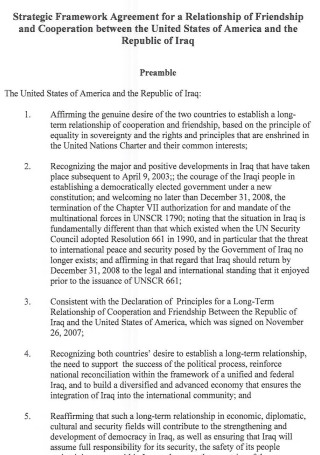
Strategic Framework Agreement
download now -
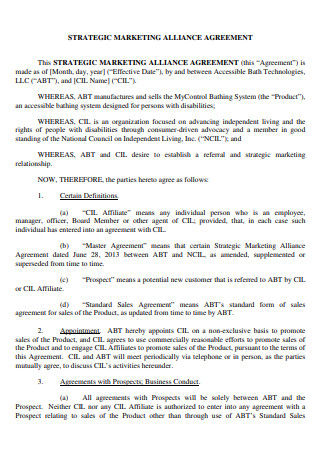
Strategic Marketing Alliance Agreement
download now -

Strategic Partnership and Licensing Agreement
download now -

Strategic Distribution Agreement
download now -
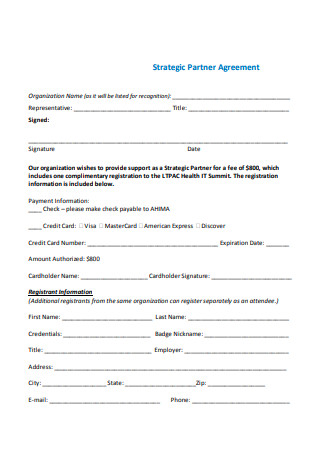
Strategic Partner Agreement
download now -
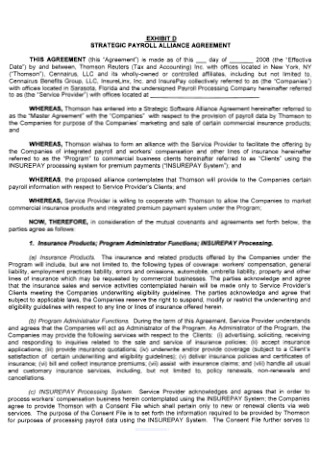
Strategic Payroll Projects Agreement
download now -

New Strategic Collaboration Agreement
download now -

Sample Strategic Agreement
download now -

Health Strategic Agreement
download now -

Network Equipment Strategic Agreement
download now -

Simple Strategic Agreement
download now -
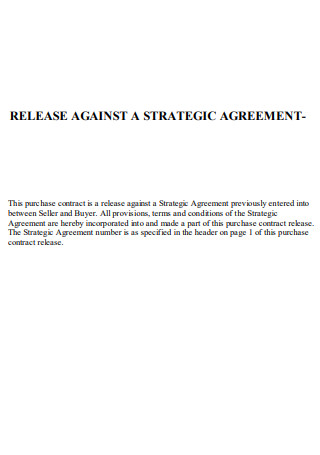
Release Against Strategic Agreement
download now -
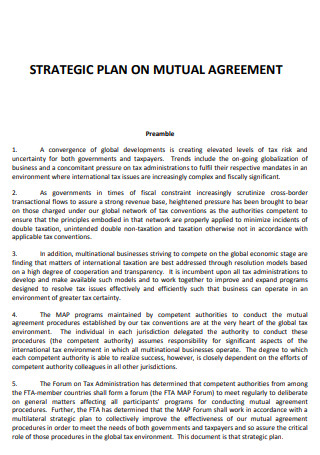
Strategic Plan on Mutual Agreement
download now -

Strategic Mandate Agreement
download now -
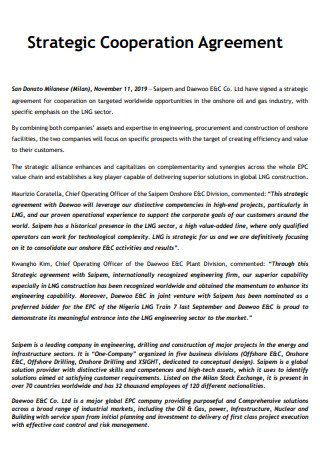
Strategic Cooperation Agreement
download now -

Strategic Agreement Example
download now -

Social Services Strategic Agreement
download now -

Strategic Statement Agreement
download now -

Strategic Performance Agreement
download now -

Annual Strategic Agreement
download now -

Strategic Agreement for Joint Development
download now -

Alliance Sign Strategic Agreement
download now -

Strategic Agreement for Dairy Products
download now -
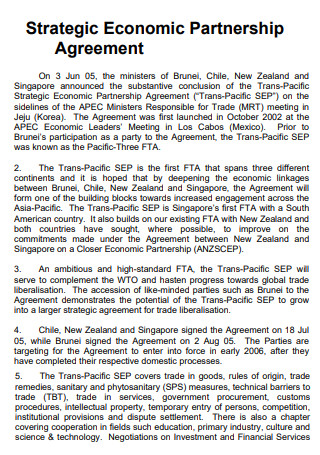
Strategic Economic Partnership Agreement
download now
FREE Strategic Agreement s to Download
30+ SAMPLE Strategic Agreement
What Is a Strategic Agreement?
Key Elements of a Strategic Agreement
Types of Strategic Partnerships
Why do Businesses Enter Strategic Alliances?
Steps in Establishing a Strategic Partnership/Alliance
FAQs
What is the role of strategic alliances in a standard product life cycle?
What is the difference between a joint venture and a strategic partnership?
What is the business model of a strategic alliance?
What Is a Strategic Agreement?
First of all, what are strategic partnerships/alliances? Well, this is the type of business relationship wherein two or more companies utilize a common resource to help achieve a common goal. Usually, strategic alliances are entered by companies for the purpose of them expanding into a completely new market. Sometimes, they may even develop an edge over the competitors in the new market if the strategic agreement proves to be successful. The alliance formed is a partnership or collaboration that aspires for harmony, with each party hoping that the advantages of the alliance would outweigh the benefits of individual efforts.
A strategic agreement is a business document that is utilized by the businesses that enter a strategic partnership/alliance in order to solidify their collaboration plans by clearly spelling out the terms and clauses to be followed throughout the agreement. It is a contractual agreement between two or more organizations to pool resources in a certain project in order to gain a competitive advantage. The contract is frequently used to share products, distribution networks, production capabilities, project funds, capital equipment, information, skills, or intellectual property.
Key Elements of a Strategic Agreement
Listed and discussed below are the key elements that need to be written in a strategic agreement:
Types of Strategic Partnerships
Listed and discussed below are some of the different types of strategic partnerships:
Why do Businesses Enter Strategic Alliances?
Listed below are some of the different reasons why businesses choose to enter strategic alliances:
Steps in Establishing a Strategic Partnership/Alliance
Entering a strategic alliance with another company has a number of benefits, some of which include the prospect of expanding your business to new markets, therefore, giving more room to grow, and it also helps your company learn something new from the partnership. With that being said, here are the common steps to take if you want to enter a strategic alliance with another company.
-
1. Establish the Things That you Need
This serves as the first step to take prior to entering a strategic partnership. It makes absolutely zero sense if you don’t know what you’re doing or if you enter a partnership blindly. In other words, establish what you really need first. Have a particular aim in mind whether your company requires assistance with distribution, marketing, money, or anything else. The only way of knowing if you’ve accomplished is to recognize what you’re aiming towards. Whenever you understand what you want, you may hunt for a spouse that shares your values.
-
2. Perform Sufficient Research
After establishing the things that your business needs in the alliance, this is the step that will follow, which is to perform sufficient research about the needs you’ve established. You can search online, call or email individuals in your network, or phone businesses to ask a few easy questions, attempt to obtain information on which firms are most likely to assist your business reach its goals, and, more significantly, which organizations are most likely to get into a partnership with you. Additionally, attempt to ensure that the collaboration is beneficial to both parties by locating a firm that requires what you supply. In this manner, they are much more likely to provide you with what your firm requires in return.
-
3. Develop an Agreement
After performing sufficient research regarding your needs, this is the next thing to do. When you’ve identified a firm that would make an excellent partner and they’ve committed to a deal, suggest having a legal professional draft an official agreement. This is due to the fact that when collaborating together to form the agreement, you might discover that both sides have their own criteria that must be worked out before signing. This is why employing a lawyer or another legal representative is beneficial. They can also assist with the creation of contract wording to ensure that all parties are satisfied before signing.
-
4. Honor the Agreement
Once all sides involved have signed the agreement that was created, it would be good practice by honoring what was included in the agreement. Once you’ve formed a business relationship, it’s critical to keep your partner’s requirements in mind whenever you work. Keep in touch with your business partner whenever appropriate, continue to refer them or uphold the agreement by giving your services. Because the objective is to benefit both firms, ensure that your business partner benefits in the success and is satisfied with the terms of the agreement. If you keep your strategic partner satisfied and perform your bit, they may be more inclined to uphold their end of the bargain.
FAQs
What is the role of strategic alliances in a standard product life cycle?
In a standard product life cycle, the firm produces a new product item every few years and may or may not be able to sustain its industry leadership position. Strategic alliances are then developed in a typical cycle to gain market share, force out rival corporations, pool resources for significant capital projects, achieve economies of scale, or get access to additional resources.
What is the difference between a joint venture and a strategic partnership?
A joint venture is a commercial arrangement in which two or more parties pool their resources to complete a specified activity or achieve a desired outcome. A strategic alliance, on the other hand, is an agreement between two or more parties to work on a mutually beneficial initiative while staying independent of one another. Fundamentally, it enables the autonomous parties to collaborate toward a shared purpose that benefits all parties involved. A joint venture’s goal is to reduce risks by working together to achieve a commercial goal. A strategic partnership, on the other hand, seeks to optimize returns and produce a profit.
What is the business model of a strategic alliance?
The business model of a strategic alliance entails chasing partners not just because they add value to your firm, but also because they may benefit from your organization’s goods, services, or brand awareness. In other words, a strategic partnership business model should be a mutually beneficial arrangement, not a one-sided agreement developed simply for the purpose of increasing income.
There are various reasons why a strategic partnership should be entered, by a startup or a growing company. At the minimum, it expands what the partners in the agreement have to offer to each other, thereby adding more value to their product or service. In this article, there are various sample templates of a strategic agreement that you can obtain as a sample when the time comes that you need to make one.
